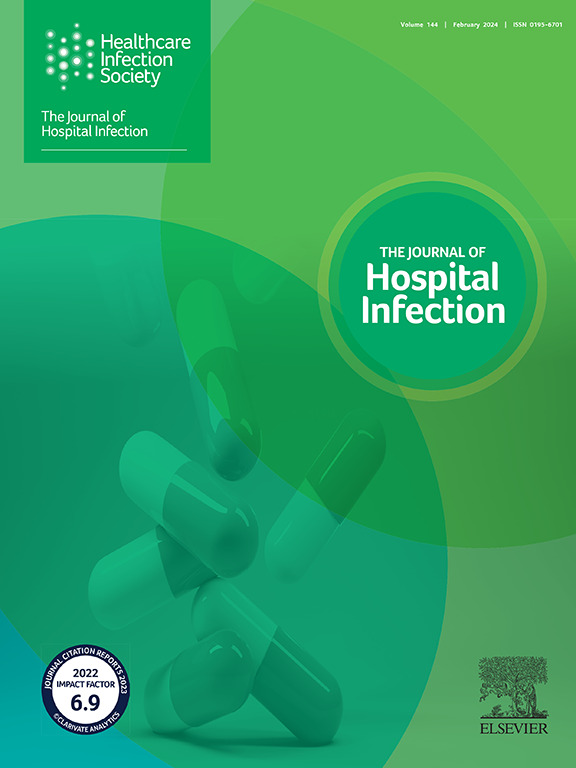Stability and inactivation of hepatitis A virus on inanimate surfaces
IF 3.9
3区 医学
Q1 INFECTIOUS DISEASES
引用次数: 0
Abstract
Background
Hepatitis A virus (HAV) is one of the leading causes of viral hepatitis with an estimated 159 million acute infections annually. The primary route of transmission is faecal–oral through contaminated drinking water and food. Limited data regarding its surface stability and sensitivity to surface disinfectants are available. Implementing effective disinfectants could have a significant impact on the prevention of HAV transmission.
Aim
To evaluate HAV stability and sensitivity to surface disinfectants based on an established carrier assay.
Methods
The stability of HAV on stainless steel discs was evaluated over a period of 60 days and its sensitivity to different commercially available surface disinfectants. Steel-disc carriers were inoculated with HAV particles and incubated over a respective period. Furthermore, HAV resistance against several groups of disinfectant agents were tested with varying concentrations and exposure times according to the manufacturers' guidelines.
Findings
HAV was recoverable from stainless steel discs for up to 40 days with an estimated half-life of 18.63 days. The evaluation of several surface disinfectants showed that, except for the aldehyde-based products, all other products insufficiently inactivated HAV.
Conclusion
Overall, HAV demonstrated a high resistance to a wide range of the tested surface disinfectants. Out of the nine surface disinfectants evaluated, only two aldehyde-based products demonstrated a reduction in viral titre below the limit of detection. These findings have strong implications for the recommendation of evidence-based hygiene guidelines to reduce HAV transmission.
甲型肝炎病毒在无生命表面的稳定性和灭活。
背景:甲型肝炎病毒(HAV)是病毒性肝炎的主要原因之一,每年估计有1.59亿急性感染。主要传播途径是通过受污染的饮用水和食物粪口传播。关于其表面稳定性和对表面消毒剂敏感性的数据有限。实施有效的消毒剂可对预防甲型肝炎传播产生重大影响。因此,本研究的目的是在建立载体试验的基础上评估甲肝病毒的稳定性和对表面消毒剂的敏感性。方法:测定HAV在不锈钢盘上60 d的稳定性及对不同市售表面消毒剂的敏感性。用HAV颗粒接种钢盘载体,孵育相应的时间。此外,根据制造商的指导方针,在不同浓度和不同暴露时间下,测试了甲肝病毒对几组消毒剂的耐药性。结果:我们观察到HAV可以从不锈钢盘中恢复长达40天,估计半衰期为18.63天。几种表面消毒剂的评价表明,除醛基产品外,其他产品均不能充分灭活甲肝病毒。结论:总体而言,甲肝病毒对多种表面消毒剂均表现出较高的耐药性。在评估的九种表面消毒剂中,只有两种基于醛的产品显示病毒滴度降至检测极限以下。这些发现对推荐循证卫生指南以减少甲肝传播具有重要意义。
本文章由计算机程序翻译,如有差异,请以英文原文为准。
求助全文
约1分钟内获得全文
求助全文
来源期刊

Journal of Hospital Infection
医学-传染病学
CiteScore
12.70
自引率
5.80%
发文量
271
审稿时长
19 days
期刊介绍:
The Journal of Hospital Infection is the editorially independent scientific publication of the Healthcare Infection Society. The aim of the Journal is to publish high quality research and information relating to infection prevention and control that is relevant to an international audience.
The Journal welcomes submissions that relate to all aspects of infection prevention and control in healthcare settings. This includes submissions that:
provide new insight into the epidemiology, surveillance, or prevention and control of healthcare-associated infections and antimicrobial resistance in healthcare settings;
provide new insight into cleaning, disinfection and decontamination;
provide new insight into the design of healthcare premises;
describe novel aspects of outbreaks of infection;
throw light on techniques for effective antimicrobial stewardship;
describe novel techniques (laboratory-based or point of care) for the detection of infection or antimicrobial resistance in the healthcare setting, particularly if these can be used to facilitate infection prevention and control;
improve understanding of the motivations of safe healthcare behaviour, or describe techniques for achieving behavioural and cultural change;
improve understanding of the use of IT systems in infection surveillance and prevention and control.
 求助内容:
求助内容: 应助结果提醒方式:
应助结果提醒方式:


